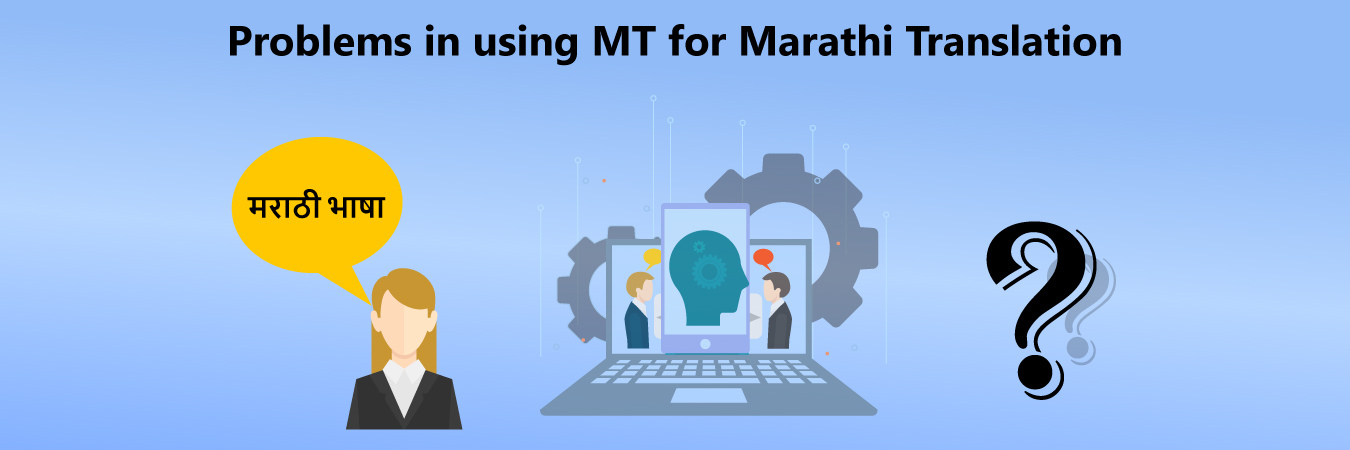
Problems in using MT for Marathi Translation
Sometime back, I received an assignment of translating an English book into Marathi. The concept was fascinating at the start but as time went by, I realized it was not my cup of tea.
The book content had too many idioms, and every now and then, I was struggling to find the exact meaning of a phrase. I could not control my laughter when I just went through an online Machine Translation (MT), just because, I had stuck at the phrase “Wild goose chase”. The MT translates the term as “वन्य हंस पाठलाग (???)”. As we know, it did not even make any sense in the Marathi language.
As we all are living in a world of automation, a language translator cannot be an exception. We know that language is key for communication between every individual. May it be a business client, may it be a simple day-to-day work, or helping a foreigner in a market, in your respective country. Although with each passing day, the translation technology using increasingly AI and is growing more and more powerful, it’s not yet as accurate as human translation.
The machine translation may work with small sentences where the meaning will not be misunderstood. But so far, the level of human translation is unmatchable. Why? Let’s see.
Every language is unique and similarly, there are quite a few challenges we face in the Marathi language when automatically translating any Marathi text. Do you know that machine translation has limitations when it comes to relating words to the context? The following are some major hurdles while taking the help of Machine Translation.
- Difficult for machines to relate words to the context
For the same word having different meanings, the machine may randomly choose a related word and this may sometimes result in a disastrous situation. For example, the Marathi word “मान” has two different meanings “neck and respect”. The machine translator is able to differentiate between the meanings to translate correctly. Here are some examples that will make you think about the issue.- For example, if someone has a name “आनंद”, a machine translator will translate that as “happy” in English as it will not understand that it is a person’s name.
- Also in Marathi, the word “खाली” has two different meaning in English “empty and downside”. Similarly, the word “बस” in Marathi means sitting whereas in English it is known as a traveling vehicle.
- In Marathi, there are words with dual meanings and that can be a vital difficulty for the machine translators. For example, In Marathi “वर” means “above” in English, also it has other meaning in Marathi in terms of “वधू-वर” which in terms of “Bride and Groom” English. What if an intended meaning is not conveyed correctly?
- Imitating style and pitch
Do you know each document is written with various styles and pitches? A document can have dramatic, comic or powerful style and pitch but when it comes to translation, it is difficult for machines to understand the same. Here the machine translator can create something meaningless. Suppose there is a phrase “…and her eyes burst into tears”. So, is it really possible for a machine translation to understand the feeling in this phrase? The machine translator will miss the expected resonance and elaborate distinctions of the original document thus creating something that is dull - Dealing with Marathi Dialects
We find several variations in the dialect of the Marathi language. Translation of any dialect would require a separate approach wherein local words and phrases are relevantly incorporated in the translated text. The sub-dialects of Marathi language are Ahirani, Dangi, Vadvali, Samavedi, Khandeshi, Koli Kokani and Malwani. For example, if the source is “Full/Complete”, in standard Marathi the translation will be “संपूर्ण ” but in the case of “Ahirani” it will be “आख्खा”. So, is it really possible for a machine translation to correctly translate an idiom in a local dialect?
So, these are some of the many problems we face in machine translation so far. Now it is our duty to think if the machine translation can be 100% correct. Can we completely rely on it? Someday you may face a financial problem if a sentence is not translated correctly. Someday someone will not be able to save another person’s life due to erroneous machine translation of a medical file. Someday, a machine will not work as expected due to erroneous machine translation of a manufacturing document and we cannot blame a machine translator for the same. All in all, machine translation might not be useful in every field and a human check is always needed. So, what are we choosing? halfway-done machine translation or a full-proof human translation?
Sampada Padhye
(Marathi Translator@Fidel SoftTech Ltd.)
Ref. No – FLB05221002
Contact Us
Are you looking for Language Services? Fill form for quick contact.
